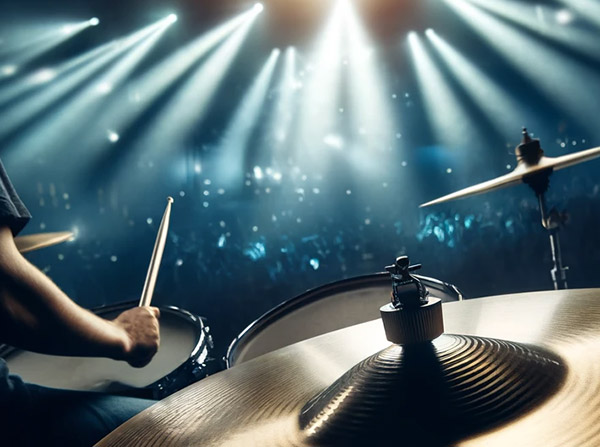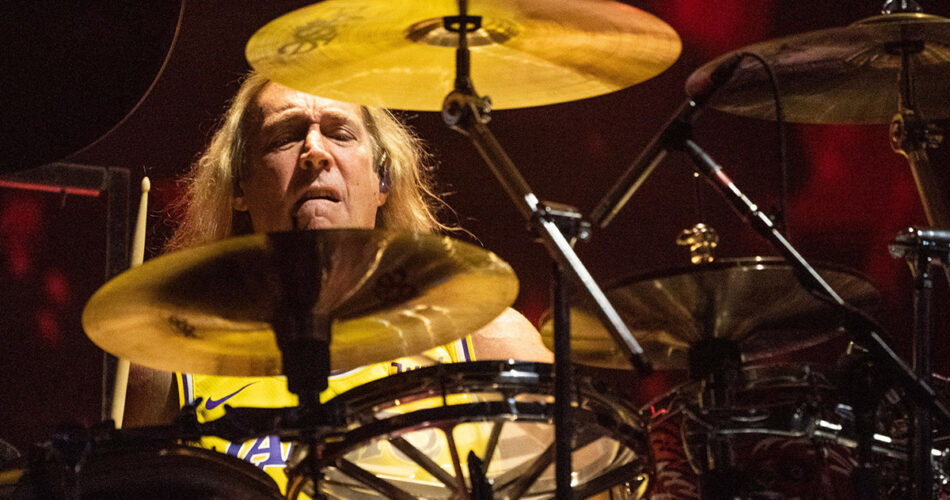Danny Carey plays for Tool, but it seems almost unfair to call him their ‘drummer’. His work for the progressive metal legends goes far beyond laying down a beat for the rest of the band to follow – he’s a true percussionist and a massive drum geek, cutting his teeth in jazz bands before bringing his signature sound (and vast drum sets) to some of the world’s biggest stages.
Carey combines elements of progressive metal, jazz, and fusion with influences from mystical and mathematical concepts, creating rhythms that are as intricate as they are powerful. Because of all this, and the fact that he can shift seamlessly between tricky time signatures like 7/8 or 11/8, he’s not an easy drummer to imitate. But if you want to give it a go, here’s a rundown of the gear he uses.
Jump to a section:
Drums
Cymbals
Heads
Pedals
Electronics
Throne
Sticks
Drums
Carey’s most famous drum set is the now legendary Paiste Signature Bronze Custom Cast kit by Jeff Ocheltree.
A drum set made by Paiste, you say?
Well yes, this beast is made from Paiste Signature cymbals that were melted down and reshaped into a full drum set with 6 toms and 2 bass drums.
Here’s a video of Carey playing part of Tool’s Lateralus on a scaled-back version of this kit. Look out for that one-armed gong strike!
Each bass drum weighs around 90lb (more than 40kg), so this kit is not exactly light, but Carey has actually toured with it.
Given how impractical that kit is, the next best thing for drummers wanting to emulate Carey’s sound is his Sonor SQ2 kit (which he has also heavily customized).
I was a big fan of the old Signature Bubingas and stuff from the 80s, and I really loved the small toms that had the really thick shells. But I found sometimes the low end didn’t resonate quite as well and I liked the thinner shells. So I had them make each shell so that they gradually get thinner as the drums get bigger.
Danny Carey
Here’s Carey’s set up for the Fear Inoculum tour, showing the exact sizes of the drums used. Most of these are either customized for Carey or (in the case of the snare drum) extremely rare. But Sonor does still make ‘regular’ SQ2 drums.
| Drum | Size |
|---|---|
| Kick drum 1 | Sonor SQ2 18″ x 22″ |
| Kick drum 2 | Sonor SQ2 20″ x 24″ |
| Snare drum | Sonor HLD590 14″ x 8″ (Cast bronze) |
| Rack tom 1 | Sonor SQ2 8″ x 8″ |
| Rack tom 2 | Sonor SQ2 10″ x 10″ |
| Extras | Remo 14″ Rototom |
| Floor tom 1 | Sonor SQ2 16″ x 14″ |
| Floor tom 2 | Sonor SQ2 18″ x 16″ |
| Gong drum | Sonor SQ2 16″ x 22 |
Cymbals
If you’re a fan of Tool you’ll know that the attention to detail in their work is pretty wild – and that extends to the sound of the cymbals too.
Carey has even been known to fill the recording studio with helium (yes, helium) to try and improve the sound of his cymbals. As he told The Skinny in 2006, close to the launch of 10,000 Days:
We tried to get more audio transients, especially out of the cymbals. We figured that if the air is thinner then high end frequencies will travel quicker.
Danny Carey
Danny Carey has been an official Paiste artist since 1992, so he only uses Paiste cymbals.
His current ‘normal’ set up includes 15 different Paiste cymbals (or 16, if you include the massive 30″ symphonic gong that hangs behind his kit).

Most of his cymbals are from the Signature series, which has been going since 1989 and are used by other drummers like Stewart Copeland and Nick Mason (from that other sometimes-proggy band, Pink Floyd).
One of the most instantly recognisable cymbals in his set up is the 22″ Dry Heavy Ride ‘Monad’, which has a cool purple finish and is, according to Carey, “beautiful and harmonic”.
His set up hasn’t always been quite so elaborate. Here’s exact cymbal configuration he used on Tool’s second studio album Ænima, which came out in 1996.
| Cymbal | Size and type |
|---|---|
| Hi-hats | Paiste 14″ Signature Dark Crisp |
| Chime | Paiste 6″ Bell Chime |
| China | Paiste 22″ 2002 Novo China |
| Splash | Paiste 8″ Signature Splash |
| Crash | Paiste 18″ Sound Formula Thin Crash |
| Crash | Paiste 18″ Signature Full Crash |
| Ride | Paiste 22″ Signature Dry Heavy Ride |
| China | Paiste 22″ Signature Thin China |
| Crash | Paiste 20″ Signature Power Crash |
Heads
Carey has always preferred Evans drum heads, and has been sponsored by the brand for more than two decades.
When put through the test of Tool, Evans drum heads maintain their tuning far beyond any other drum heads.
Danny Carey
Specifically, he uses a Power Center head on the batter side of his snare drum.
He says: “The coating provides that extra bit of articulation.
“I go through 2 or 3 snare heads every night when I’m playing because I hit pretty hard.”
Elsewhere he uses clear Evans G2 Heads on the top of the toms, with G1 skins on the resonant side.
On his bass drum, the beaters whack into a clear, 22″ EQ3 Bass Drum Head. The front is covered by a customized EQ3 Resonant head (often with designs inspired by sacred geometry).
One cool little side note: Carey will often tune his rack toms to the key of the song when recording. [1]
Pedals

Carey says he used to play Sonor pedals with an offset cam (the metal part of the pedal that transfers energy to the beater).
However, he recently switched to Pearl Eliminator bass drum pedals with the beaters pulled all the way back.
Combined with an offset cam, these pedals give him a nice ‘crack’ on each stroke of the pedal, helping him cut through the rest of the Tool sound.
Electronics
Carey’s drum sets are big, band he augments them with a whole load of pads, triggers and electronic instruments.
For example, Carey uses Mandala pads by Synesthesia, which can be set up with different sounds on each of the surface triggers.
I can program the pads so there’s three different sections on each
Danny Carey on his Mandala pads
When he’s playing live with Tool, Carey uses at least seven of these pads, which can be mounted on regular drum hardware.
In addition, Carey uses a KORG Wavedrum from the 1990s, a Roland HandSonic HPD-20 and a super-rare Marimba Lumina midi controller designed by the engineer Don Buchla.
Throne
Carey often uses a ROC-N-SOC Nitro Throne, which comes with a nitrogen shock absorber that “gives bounce to the seat for reduced back fatigue”.
These thrones can be ordered with an optional back rest, but Carey doesn’t use one.
Sticks
Carey uses signature Vic Firth sticks that he helped to design, including a slightly indented section near the base of the stick to improve grip.
Danny’s signature stick is a true reflection of his style and versatility.
Vic Firth website
An unexpected side effect of the tapered handle is that these sticks have a bit more weight at the top, giving them a nice ‘crack’ when playing.


Comments